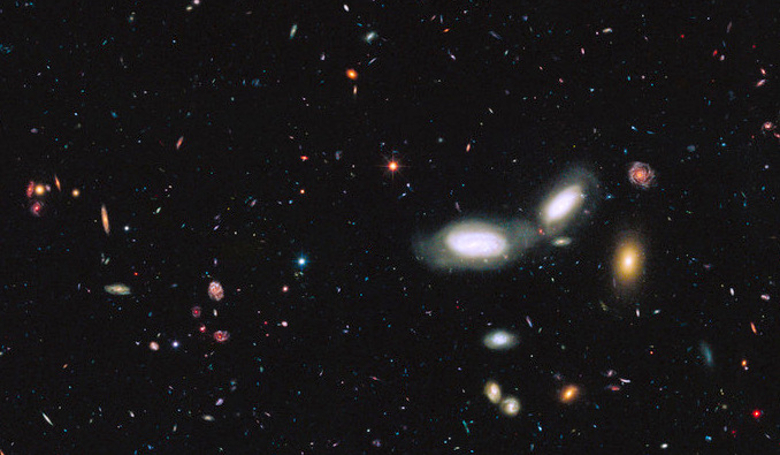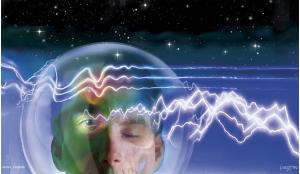Our current, widely recognised model of the Universe, is that 95 percent of it is made up of dark ‘stuff’ that on one hand stops galaxies from tearing themselves apart, while on the other is causing space to expand at an accelerated rate. But what if dark energy and dark matter were one and the same thing? And, controversially, a thing that is described as a fluid which possesses ‘negative mass’?
This is the finding of a scientist at the University of Oxford who may just have solved one of the biggest problems in modern physics; the unification of dark matter and dark energy into a single phenomenon.
Dark matter and dark energy are strange substances. Albert Einstein first provided a hint that the Universe was full of dark energy exactly 100 years ago, when he discovered a parameter in his equations known as the 'cosmological constant.’ Although he would later describe it as his ‘biggest blunder,’ modern astrophysical observations prove that it is a real phenomenon. However no-one really knows for sure what it, or dark matter looks like physically.
Dark matter is perhaps easier to envisage, because like visible matter it should be quantifiable, it just happens to be hidden or obscured from sight. Right? At least thats how the theory goes. So far two leading suggestions have been put forward to explain what it might be. Is it large unseen particles that interact weakly with other matter (particles known as WIMPS), or an astronomical body that might explain the apparent presence of dark matter in galaxy halos (a theory known as MACHOs - massive astrophysical compact halo object)? But again, to date, despite extensive searches nothing concrete has been found.
Perhaps the reason a WIMP has gone undetected is because dark matter and its mysterious counterpart, dark energy are not what we thought they are after all.
'We now think that both dark matter and dark energy can be unified into a fluid which possesses a type of 'negative gravity', repelling all other material around them. Although this matter is peculiar to us, it suggests that our cosmos is symmetrical in both positive and negative qualities,’ explains Dr Jamie Farnes from the Oxford e-Research Centre, who led the research.
Simulations of this negative mass show that when more and more negative masses continually burst into existence, it does not dilute during the expansion of the cosmos - a problem that previous theories of negative mass could not overcome. Instead, the fluid appears to be identical to dark energy and does not thin out over time and it does this with the aid of a 'creation tensor', which allows for negative masses to be continuously created.
Not only that, but the properties of negative mass predicts the formation of dark matter halos to keep galaxies from flying apart. 'The outcome seems rather beautiful: dark energy and dark matter can be unified into a single substance, with both effects being simply explainable as positive mass matter surfing on a sea of negative masses,’ said Farne. Negative mass also has the curious property of accelerating towards you, if you were to push it away.
Ironically, a negative-mass-filled universe was also described by Einstein as far back as 1918 when he wrote that 'a modification of the theory is required such that "empty space" takes the role of gravitating negative masses which are distributed all over the interstellar space,’ to describe his cosmological constant.
Being able to unify the two darknesses is therefore a big plus for Farne’s theory. 'Previous approaches to combining dark energy and dark matter have attempted to modify Einstein's theory of general relativity, which has turned out to be incredibly challenging. This new approach takes two old ideas that are known to be compatible with Einstein's theory - negative masses and matter creation - and combines them together.
Although the theory is still just that – a theory – its viability has the scope to be fully tested. Farne says that spatial pockets of negative mass with particularly high or low creation rates can give rise to a Hubble parameter (the unit of measurement used to describe the expansion of the universe), that varies over time.
As space and time are connected (space-time), this would manifest as an uneven distribution of expansion speeds across the sky that varies around individual voids in the galaxy distribution. Cutting-edge radio telescopes such as the Square Kilometre Array (SKA) should be able to measure the galaxy distribution to see if this effect from negative matter creation is taking place.
But there is still a long way to go says Farne. 'There are still many theoretical issues and computational simulations to work through, and LambdaCDM has a nearly 30 year head start, but I'm looking forward to seeing whether this new extended version of LambdaCDM can accurately match other observational evidence of our cosmology. If real, it would suggest that the missing 95 percent of the cosmos had an aesthetic solution: we had forgotten to include a simple minus sign.’











